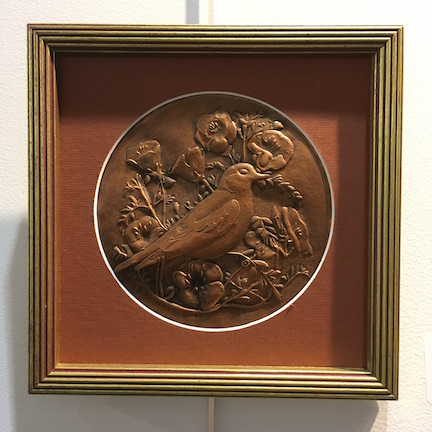Exploring the Repoussé Work of Thomas Hammet
Thomas Hammet of Flint Hill Innovations, Sonora, Kentucky, takes great satisfaction in the malleability of copper.
“When I hit on a piece on a metal I can see it growing into shape,” he says. “It gives me chills. You don’t get that in wood(working), (which) almost has to be subtractive… It’s almost like modeling clay.”
 A repoussé copper piece by Thomas Hammet.
A repoussé copper piece by Thomas Hammet. Photo courtesy of Thomas Hammet.
Hammet, a craftsman, instructor and Central Kentucky Art Guild member, has exhibited his copper and silver pieces as part of the guild’s permanent rotating displays as well as in the Morrison Gallery at the Elizabethtown Community and Technical College in Elizabethtown, Kentucky.
His latest commission is a piece for Central Kentucky Community Foundation, at its Home of Philanthropy. He will also have a three-month display of assorted art pieces there.
Hammet uses a technique called chasing and repoussé. Repoussé is a French word meaning "to push from the back."
“A piece of sheet metal is hammered on the back side to produce volume and a general shape,” Hammet explains.”The piece is then hammered on the front (chasing) to give detail.”
For the viewer, one of the special features of chasing repoussé pieces is that they usually aren’t covered and invite an encounter of texture, he said. For the creator, the process, though open to adaptations, requires commitment.
Hammett said although chasing and repoussé takes a substantial amount of time (even a small piece is measured in tens of hours) there is great satisfaction in taking a piece of metal from flat sheet to a finished 3D piece of art.
“Copper is a very forgiving metal, and quite inexpensive compared to silver or gold. It's a good practice metal for silver, as well,” he says. “Copper and silver work at about the same temperatures, and feel very similar when hammering. So I can produce a piece in copper, and work out all the problems, before rendering the piece in silver, which is much more expensive.”
Hammet did woodworking before discovering an affinity for chasing and repoussé.
“Back in 2005, I was in my garage shop, just piddling around. Just for grins, I took a copper penny and hammered on it to see how thin I could get it,” he recalls. “A penny is actually rather hard, and I couldn't get it very thin. Then I thought I'd melt it.”
Using a standard propane torch, he couldn't get it hot enough to melt, only glow.
“After it cooled, I hit it again and was surprised at how soft it felt and how much it thinned out,” he said. “Without knowing anything about the process, I annealed the copper, making it softer. For the next few years, I annealed and hammered out a lot of copper pennies, and it was very satisfying.”
In 2008, a friend asked him to make a plaque using his business card logo, figuring Hammet would use wood.
“After thinking about it, I decided on metal,” he said.”I took a copper elbow for plumbing, annealed it, split it and hammered it out into a sheet, and then hammered his logo from the back side using a cut-off nail and a hammer.”
It wasn’t until six years later that he learned that the process he was using had a name. He took the chasing and repousse class at William Holland School of Lapidary Arts.
“Within just a few minutes into the course I decided I would do that for the rest of my life,” said Hammett, 67.
Hammet prefers pieces from nature such as birds and flowers and geometric pieces. Central Kentucky Art Guild’s monthly competitions, though, were based on specific themes, so he had to branch out.
Hammet studied with repousse master Valentin Yotkov and maintains a friendship with him.
Now that Hammet also teaches he appreciates how such relationships nourish both the teacher and the student.
“I actually learn more as a teacher than as a student,” Hammet said. “Students' viewpoints are different from those of the teacher, and you have to look at problems differently. They also give me different design ideas. Plus, all of my work is done alone. When you are surrounded by people with a similar interest there is a dynamic that is truly amazing. Although teaching is more fatiguing than actual chasing, the energizing effect of having seven or eight other chasers together is really great.”
Resources:
Also in this Issue:
- An Ancient Conversation with Copper
- David Tudor Sound Sculpture Comes to MOMA
- Rumors of War Sculpture Debuts in New York
- Exploring the Repoussé Work of Thomas Hammet
- Sculptor Kevin Jenkins and His Serendipitous Road to Copper
